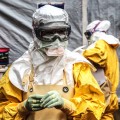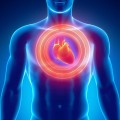Fractionation of functional peptides with ion-exchange membrane adsorption chromatographySeparation via binding - von Prof. Dr Ulrich Kulozik, Elena Leeb
By deploying specific proteases for the enzymatic hydrolysis of proteins, the release of peptides can be controlled. This process can be used to produce functional peptides, which may exhibit an ability to reduce blood pressure or have a surface-active function. The deployment of biofunctional peptides in food as an “added value” is only possible at sufficiently effective concentrations, however. Accordingly, processes are required that...
 Ebola outbreak in West AfricaA mysterious fever - von Dr Thomas Strecker, Dr Gordian Schudt, Dr Svenja Wolff, Anne Kelterbaum, Dr Markus Eickmann, Prof. Dr Stephan Becker
In early March this year, deep in the forest region of southeast Guinea, cases started to accumulate for a mysterious fever that claimed many lives among its sufferers. Muscle pain, high fever, vomiting and severe diarrhoea – all symptoms that doctors often observe in Africa's hospitals, but this time, all attempts to treat them proved futile.
 MOSH/MOAH food contaminationFocus on mineral oil residues - von Prof. Dr. Reinhard Matissek, Dr. Marion Raters, Anna Dingel, Julia Schnapka
Mineral oils are almost universally present in our environment. Their constituents can infiltrate foods of both plant and animal origin in many different ways. From the perspective of their chemical structure, the main compounds of interest are mineral oil saturated hydrocarbons (MOSH) and – to a proportionally lesser extent – mineral oil aromatic hydrocarbons (MOAH).
 Viruses in the waterDetection and analysis of human viral pathogens in surface waters - von Dr. Lars Jurzik, Mats Leifels
Alongside the development of methods for quantifying human viral pathogens in surface and waste waters, a key role is also played by the analysis of the resultant data. While drinking water supplies must be safeguarded on the one hand, the public must also be able to pursue waterrelated recreation activities without fearing health risks.
 When tuberculosis faces an even stronger opponentDetecting tuberculosis – contribution to the battle against infectious diseases - von Carl ZEISS Microscopy Jena
Tuberculosis (TB) is second only to HIV/ AIDS for the dubious distinction of being the world’s greatest killer. TB is a bacterial disease caused by a single infectious agent, <i>Mycobacterium tuberculosis</i>,which most commonly affects the lungs. It is transmitted from person to person via droplets from the throat and lungs of people who have the active respiratory disease.
 A new application for microscopyNon-Invasive Cancer Diagnosis - von Dr Leo Habets
Cancer has been a part of human life from our earliest days. In research conducted by Aachen-based oncologist Dr Leo Habets, a non-invasive, microscope-based diagnostic procedure has the potential to revolutionise research and progress in understanding the circumstances of the disease, so as to develop new therapeutic approaches. Microscope-based high-content screening systems in basic clinical research: can a non-invasive procedure replace the...
 Re-creating cardiac tissueA Heart in a Petri Dish - von Prof. Dr Marko D. Mihovilovic
For medical research in the 21st century, regenerative medicine offers one of the most promising futures and prospects for further development. Revolutionary results have already been achieved by the efforts of genetic engineering, although ethical and regulatory aspects mean that such methods are unlikely to see widespread deployment.
A complementary approach is now being pursued by the application of small-molecule compounds: a rapidly growing...  Data Visualization in Medicinal ChemistryHiking Trails in Activity Landscapes - von Prof. Dr Jürgen Bajorath
The massive growth of compound activity data provides opportunities and challenges for medicinal chemistry. Conventional approaches for the analysis of structure-activity relationships (SARs) are not suitable for the exploration and exploitation of this unprecedented knowledge base. Recently, new computational methodologies have been introduced for large-scale SAR analysis that put emphasis on visualization to provide an intuitive access to complex...
 labor&more in interview with prize-winning scientist Dr. Ben Lehner‘Luckily, Individuals Turn out to Be Different.’
Why are individuals different? Why do the same mutations in the genome have different effects on different individuals? Why does one twin get sick when another does not? How do sicknesses come about through the combination of different mutations? These are the questions which British scientist Dr Ben Lehner – ICREA Research Professor, EMBL-CRG Systems Biology Unit, at the Centre de Regulació Genòmica (CRG) in Barcelona – investigates in his...
 The earliest plasma marker for myocardial infarctionFabulous FABP - von Prof Dr Reinhard Renneberg, Prof. Dr Jan F.C. Glatz
The application of Fatty Acid-Binding Protein (FABP) as a plasma marker for the diagnosis of acute myocardial infarction was first suggested in 1988. Currently, FABP is proven to have added value for the diagnosis of patients presenting with chest pain suggestive of myocardial infarction, especially in the early hours after onset of symptoms. The routine application of FABP for this purpose not only will improve patient outcome but also markedly...
 |
|














